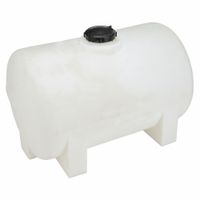Call +(254) 703 030 000 / 751 483 999 / 721 704 777
- Home
- Material Handling
- Storage Workspace
- Drums Pails Ibc Totes Tanks
- Liquid Storage Tanks Ibc Totes
.....Read More
Frequently Asked Questions
What are the standard sizes of IBC totes?
The standard sizes of Intermediate Bulk Containers (IBC totes) typically include the following:
1. **275 Gallon IBC Tote**: This is one of the most common sizes. It has dimensions of approximately 48 inches in length, 40 inches in width, and 46 inches in height. The weight when empty is around 135 pounds.
2. **330 Gallon IBC Tote**: Another popular size, the 330-gallon tote, measures about 48 inches in length, 40 inches in width, and 53 inches in height. The empty weight is approximately 160 pounds.
3. **220 Gallon IBC Tote**: Less common than the 275 and 330-gallon sizes, the 220-gallon tote has dimensions of roughly 48 inches in length, 40 inches in width, and 39 inches in height.
4. **120 Gallon IBC Tote**: This smaller size is used for specific applications and measures about 48 inches in length, 40 inches in width, and 23 inches in height.
5. **550 Gallon IBC Tote**: This is a larger size used for bulk storage and transport, with dimensions of approximately 57 inches in length, 45 inches in width, and 71 inches in height.
These sizes can vary slightly depending on the manufacturer and the specific design of the IBC tote. They are typically made from high-density polyethylene (HDPE) and are encased in a metal cage for added durability and protection. IBC totes are used for storing and transporting liquids, chemicals, food products, and other materials, offering a versatile and efficient solution for bulk handling.
How do you clean and maintain liquid storage tanks?
1. **Preparation**: Ensure all safety protocols are in place. Wear appropriate personal protective equipment (PPE) such as gloves, goggles, and masks. Isolate the tank from any connected systems and ensure it is empty.
2. **Ventilation**: Properly ventilate the tank to remove any hazardous gases. Use explosion-proof fans if necessary.
3. **Inspection**: Conduct a thorough inspection of the tank's interior and exterior for any signs of damage, corrosion, or leaks.
4. **Removal of Residues**: Use appropriate tools and equipment to remove sludge, sediments, or residues. This may involve manual scraping or using high-pressure water jets.
5. **Cleaning**: Apply suitable cleaning agents or chemicals based on the type of liquid previously stored. Use brushes, scrapers, or automated cleaning systems to ensure thorough cleaning.
6. **Rinsing**: Rinse the tank with clean water to remove any remaining cleaning agents or residues. Ensure all cleaning solutions are completely flushed out.
7. **Drying**: Allow the tank to dry completely. Use air blowers or natural ventilation to speed up the process.
8. **Inspection and Repair**: Re-inspect the tank for any damage or wear. Conduct necessary repairs, such as patching leaks or applying anti-corrosion coatings.
9. **Testing**: Perform pressure tests or other relevant tests to ensure the tank's integrity and safety.
10. **Documentation**: Record all cleaning and maintenance activities, including dates, methods used, and any repairs conducted.
11. **Regular Maintenance**: Establish a regular maintenance schedule based on the type of liquid stored and the tank's usage to ensure ongoing safety and efficiency.
What materials are IBC totes made from?
IBC totes, or Intermediate Bulk Containers, are primarily made from three types of materials:
1. **High-Density Polyethylene (HDPE):** This is the most common material used for the inner container or bottle of the IBC. HDPE is chosen for its chemical resistance, durability, and ability to withstand a wide range of temperatures. It is suitable for storing a variety of liquids, including chemicals, food products, and pharmaceuticals.
2. **Metal (Steel or Aluminum):** The outer cage or frame of an IBC tote is typically made from galvanized steel or aluminum. This metal cage provides structural support and protection for the inner container, allowing the tote to be stacked and transported safely. Steel is preferred for its strength and durability, while aluminum is used for its lightweight properties and resistance to corrosion.
3. **Composite Materials:** Some IBC totes are made from a combination of materials, such as a plastic inner container with a metal outer cage. This composite construction offers the benefits of both materials, providing chemical resistance and structural integrity.
Additionally, certain IBC totes may have liners or coatings made from materials like fluoropolymers to enhance chemical resistance or to meet specific regulatory requirements for food and pharmaceutical applications. The choice of materials depends on the intended use of the IBC tote, the nature of the contents, and the environmental conditions it will be exposed to.
How long can liquids be stored in IBC totes?
The storage duration of liquids in Intermediate Bulk Containers (IBC) totes depends on several factors, including the type of liquid, the material of the IBC, storage conditions, and regulatory guidelines. Generally, IBC totes are designed for long-term storage, but specific durations can vary:
1. **Material of IBC**: IBCs are typically made from high-density polyethylene (HDPE), stainless steel, or carbon steel. HDPE IBCs are suitable for storing non-reactive chemicals and food products, while stainless steel IBCs are used for more reactive or hazardous materials. The material affects the shelf life due to its resistance to chemical interactions.
2. **Type of Liquid**: Non-hazardous liquids like water or food-grade products can be stored for extended periods, often up to 2-5 years, if the IBC is kept in optimal conditions. Hazardous chemicals may have specific storage guidelines that limit their duration.
3. **Storage Conditions**: Proper storage conditions are crucial. IBCs should be kept in a cool, dry place away from direct sunlight and temperature extremes to prevent degradation of the container and the liquid. UV exposure can weaken plastic IBCs, while temperature fluctuations can affect the stability of the stored liquid.
4. **Regulatory Guidelines**: Compliance with local and international regulations is essential. Some chemicals have specific storage duration limits set by regulatory bodies, which must be adhered to for safety and legal reasons.
5. **Manufacturer Recommendations**: Always follow the manufacturer's guidelines for storage duration and conditions, as they provide specific information based on the IBC's design and intended use.
In summary, while IBC totes can store liquids for several years under ideal conditions, the exact duration depends on the factors mentioned above. Regular inspections and adherence to guidelines are essential to ensure the integrity of both the container and the stored liquid.
Are liquid storage tanks suitable for storing chemicals?
Yes, liquid storage tanks can be suitable for storing chemicals, but several factors must be considered to ensure safety and effectiveness. The suitability depends on the type of chemical, the tank material, and the storage conditions.
1. **Material Compatibility**: The tank material must be compatible with the chemical to prevent reactions that could lead to leaks or contamination. Common materials include stainless steel, polyethylene, and fiberglass-reinforced plastic, each suitable for different chemicals.
2. **Tank Design**: Tanks must be designed to handle the specific properties of the chemical, such as corrosiveness, volatility, and temperature sensitivity. Features like double-walled construction, pressure relief valves, and secondary containment systems enhance safety.
3. **Regulatory Compliance**: Storage tanks must comply with local, national, and international regulations, which dictate standards for construction, maintenance, and operation to prevent environmental contamination and ensure worker safety.
4. **Environmental Considerations**: Tanks should be located in areas that minimize environmental impact in case of a spill. Secondary containment systems, such as bunds or dikes, are often required to contain leaks.
5. **Operational Safety**: Proper safety measures, including regular inspections, maintenance, and monitoring systems, are essential to detect leaks or structural weaknesses early. Safety protocols for handling and transferring chemicals should be in place.
6. **Temperature and Pressure Control**: Some chemicals require specific temperature and pressure conditions to remain stable. Tanks may need insulation, heating, or cooling systems to maintain these conditions.
7. **Ventilation and Emission Control**: Adequate ventilation and emission control systems are necessary to manage fumes and vapors, especially for volatile or toxic chemicals.
In summary, while liquid storage tanks can be suitable for storing chemicals, careful consideration of material compatibility, design, regulatory compliance, and safety measures is crucial to ensure safe and effective storage.
What is the lifespan of an IBC tote?
The lifespan of an Intermediate Bulk Container (IBC) tote can vary significantly based on several factors, including the material of the tote, the conditions under which it is used, and how well it is maintained. Generally, IBC totes are designed for durability and can last anywhere from 1 to 10 years.
1. **Material**: IBC totes are typically made from high-density polyethylene (HDPE) or metal. HDPE totes are more susceptible to degradation from UV exposure and chemical interactions, while metal totes, often made from stainless steel, are more robust and can last longer if properly maintained.
2. **Usage Conditions**: The environment in which the IBC tote is used plays a crucial role in its lifespan. Totes exposed to harsh chemicals, extreme temperatures, or direct sunlight may degrade faster. Regular exposure to UV rays can cause plastic totes to become brittle over time.
3. **Maintenance**: Proper maintenance can significantly extend the life of an IBC tote. This includes regular cleaning, inspection for damage, and ensuring that the tote is used within its specified limits. Reconditioning services are available for some totes, which can further extend their usability.
4. **Regulatory Compliance**: For certain applications, especially those involving food or pharmaceuticals, regulatory standards may dictate the maximum allowable lifespan of a tote, regardless of its physical condition.
5. **Reuse and Recycling**: Many IBC totes are designed for multiple uses and can be reconditioned or recycled. Reusable totes can be cleaned and refilled multiple times, while recycling options are available for those that have reached the end of their usable life.
In summary, while the typical lifespan of an IBC tote can range from 1 to 10 years, it is highly dependent on material, usage, maintenance, and compliance with industry standards.
How do you safely transport IBC totes?
To safely transport Intermediate Bulk Containers (IBC) totes, follow these guidelines:
1. **Inspection**: Before transport, inspect the IBC totes for any damage, leaks, or defects. Ensure that the containers are properly sealed and labeled according to the contents and relevant regulations.
2. **Secure Loading**: Use appropriate equipment like forklifts or pallet jacks to load the IBC totes onto the transport vehicle. Ensure that the totes are placed on a flat, stable surface.
3. **Proper Stacking**: If stacking is necessary, follow the manufacturer's guidelines for maximum stacking height. Ensure that the totes are aligned and stable to prevent shifting during transit.
4. **Securing Totes**: Use straps, ropes, or nets to secure the IBC totes to the vehicle. This prevents movement and potential tipping during transport. Ensure that the securing devices are in good condition and properly fastened.
5. **Weight Distribution**: Distribute the weight evenly across the transport vehicle to maintain balance and stability. Avoid overloading the vehicle beyond its weight capacity.
6. **Regulatory Compliance**: Adhere to all local, national, and international regulations regarding the transport of hazardous materials, if applicable. This includes proper labeling, documentation, and handling procedures.
7. **Driver Training**: Ensure that the driver is trained in handling and transporting IBC totes, especially if they contain hazardous materials. The driver should be aware of emergency procedures in case of an accident or spill.
8. **Route Planning**: Plan the transport route to avoid rough roads, sharp turns, and steep inclines that could destabilize the load. Consider weather conditions and traffic to minimize risks.
9. **Regular Checks**: During transport, make regular stops to check the condition and security of the IBC totes. Address any issues immediately to prevent accidents.
10. **Unloading**: Upon arrival, carefully unload the IBC totes using appropriate equipment, ensuring that they are placed in a safe and secure location.



